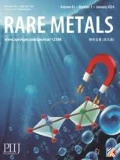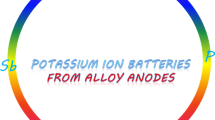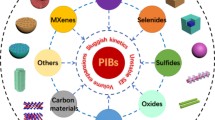Abstract
Potassium-ion batteries (KIBs) are one of the most promising large-scale electric energy storage systems due to the high abundance and low redox potential of K. As the key component, anode determines their energy density and safety. Alloy-based anodes, such as P, Sn, Sb, and Bi, have attracted extensive attention due to their abundant resources, suitable working potentials, and large theoretical capacities. However, the dramatic volume variation upon (de)potassiation results in pulverization of particles and their detaching from the current collector accompanied with performance decay. Various strategies, including designing micro-/nanostructures, introducing carbon substrates, and optimizing electrode/electrolyte interface, have been demonstrated to effectively alleviate these issues. Herein, we summarize the recent research progresses on alloy-based materials in KIBs. The synthesis methods, electrochemical performance, reaction mechanisms, and structure–activity relationships of these materials are considered, and challenges and perspectives are provided. This review provides new insight into designing of high-activity electrode materials for KIBs and beyond.
Graphic abstract








(reprinted with permission [89], Copyright 2019 Royal Society of Chemistry)

(reprinted with permission [41], Copyright 2018 John Wiley and Sons)

(reprinted with permission [41], Copyright 2018 John Wiley and Sons)

Similar content being viewed by others
References
Liang Y, Zhao J, Han Z, Yu H. Application of lithium rare metal in rechargeable batteries. Chin J Rare Met. 2019;43(11):1187.
Liu T, Zhao SX, Gou LL, Wu X, Nan CW. Electrochemical performance of Li-rich cathode material, 0.3Li2MnO3–0.7LiMn1/3Ni1/3Co1/3O2 microspheres with F-doping. Rare Met. 2019;38(3):189.
Zhang J, Cheng F, Chou S, Wang J, Gu L, Wang H, Yoshikawa H, Lu Y, Chen J. Tuning oxygen redox chemistry in Li-rich Mn-based layered oxide cathode by modulating cation arrangement. Adv Mater. 2019;31(42):1901808.
Mu C, Lei K, Li H, Li F, Chen J. Enhanced conductivity and structure stability of Ti4+ doped Li3VO4 as anodes for lithium-ion batteries. J Phys Chem C. 2017;121(47):26196.
Hu Z, Tai Z, Liu Q, Wang S, Jin H, Wang S, Lai W, Chen M, Li L, Chen L, Tao Z, Chou S. Ultrathin 2D TiS2 nanosheets for high capacity and long-life sodium ion batteries. Adv Energy Mater. 2019;9(8):1803210.
Wang S, Jing Y, Han L, Wang H, Wu S, Zhang Y, Wang L, Zhang K, Kang Y, Cheng F. Ultrathin carbon-coated FeS2 nanooctahedra for sodium storage with long cycling stability. Inorg Chem Front. 2019;6(2):459.
Slater MD, Kim D, Lee E, Johnson CS. Sodium-ion batteries. Adv Funct Mater. 2013;23(8):947.
Wang PF, You Y, Yin YX, Guo YG. Layered oxide cathode for sodium-ion batteries: phase transition, air stability, and performance. Adv Energy Mater. 2018;8(8):1701912.
Vaalma C, Giffin GA, Buchholz D, Passerini S. Non-aqueous K-ion battery based on layered K0.3MnO2 and hard carbon/carbon black. J Electrochem Soc. 2016;163(7):A1295.
Chen Y, Luo W, Carter M, Zhou L, Dai J, Fu K, Lacey S, Li T, Wan J, Han X, Bao Y, Hu L. Organic electrode for non-aqueous potassium-ion batteries. Nano Energy. 2015;18:205.
Wu D, Zhang W, Feng Y, Ma J. Necklace-like carbon nanofibers encapsulating V3S4 microspheres for ultrafast and stable potassium-ion storage. J Mater Chem A. 2020;8(5):2618.
Jian Z, Xing Z, Bommier C, Li Z, Ji X. Hard carbon microspheres: potassium-ion anode versus sodium-ion anode. Adv Energy Mater. 2016;6(3):1501874.
Chen M, Liu Q, Wang S, Wang E, Guo X, Chou S. High-abundance and low-cost metal-based cathode materials for sodium-ion batteries: problems, progress, and key technologies. Adv Energy Mater. 2019;9(14):1803609.
Xu B, Qi S, Li F, Peng X, Cai J, Liang J, Ma J. Cotton-derived oxygen/sulfur co-doped hard carbon as advanced anode material for potassium-ion batteries. Chin Chem Lett. 2020;31(1):217.
Eftekhari A, Jian Z, Ji X. Potassium secondary batteries. ACS Appl Mater Interfaces. 2017;9(5):4404.
Wu X, Leonard DP, Ji X. Emerging non-aqueous potassium-ion batteries: challenges and opportunities. Chem Mater. 2017;29(12):5031.
Matsuura N, Umemoto K, Takeuchi Z. Standard potentials of alkali metals, sliver, and thallium metal/ion couples in N, N′-dimethylformamide, dimethyl sulfoxide, and propylene carbonate. Bull Chem Soc Jpn. 1974;47(4):813.
Zhao J, Zou X, Zhu Y, Xu Y, Wang C. Electrochemical intercalation of potassium into graphite. Adv Funct Mater. 2016;26(44):8103.
Zhang W, Liu Y, Guo Z. Approaching high-performance potassium-ion batteries via advanced design strategies and engineering. Sci Adv. 2019;5(5):eaav7412.
Hosaka T, Shimamura T, Kubota K, Komaba S. Polyanionic compounds for potassium-ion batteries. Chem Rec. 2019;19(4):735.
Lei K, Li F, Mu C, Wang J, Zhao Q, Chen C, Chen J. High K-storage performance based on the synergy of dipotassium terephthalate and ether-based electrolytes. Energy Environ Sci. 2017;10(2):552.
Zhou J, Wang L, Yang M, Wu J, Chen F, Huang W, Han N, Ye H, Zhao F, Li Y, Li Y. Hierarchical VS2 nanosheet assemblies: a universal host material for the reversible storage of alkali metal ions. Adv Mater. 2017;29(35):1702061.
Zou X, Xiong P, Zhao J, Hu J, Liu Z, Xu Y. Recent research progress in non-aqueous potassium-ion batteries. Phys Chem Chem Phys. 2017;19(39):26495.
Xie X, Qi S, Wu D, Wang H, Li F, Peng X, Cai J, Liang J, Ma J. Porous surfur-doped hard carbon for excellent potassium storage. Chin Chem Lett. 2020;31(1):223.
Jian Z, Luo W, Ji X. Carbon electrodes for K-ion batteries. J Am Chem Soc. 2017;137(36):11566.
Kishore B, Venkatesh G, Munichandraiah N. K4Ti4O9: a promising anode material for potassium-ion batteries. J Electrochem Soc. 2016;163(13):A2551.
Han J, Xu M, Niu Y, Li G-N, Wang M, Zhang Y, Jia M, Li CM. Exploration of K2Ti8O17 as an anode material for potassium-ion batteries. Chem Commun. 2016;52(75):11274.
Schuppert ND, Mukherjee S, Bates AM, Son EJ, Choi MJ, Park S. Ex-situ X-ray diffraction analysis of electrode strain at TiO2 atomic layer deposition/α-MoO3 interface in a novel aqueous potassium-ion battery. J Power Sources. 2016;316:160.
Gao H, Zhou T, Zheng Y, Zhang Q, Liu Y, Chen J, Liu H, Guo Z. CoS quantum dot nanoclusters for high-energy potassium-ion batteries. Adv Funct Mater. 2017;27(43):1702634.
Xie J, Zhu Y, Zhuang N, Li X, Yuan X, Li J, Hong G, Mai W. High-concentration ether-based electrolyte boosting electrochemical performance of SnS2-reduced graphene oxide for K-ion batteries. J Mater Chem A. 2019;7(33):19332.
Ren X, Zhao Q, McCulloch WD, Wu Y. MoS2 as a long-life host material for potassium ion intercalation. Nano Res. 2017;10(4):1313.
Lakshmi V, Chen Y, Mikhaylov AA, Medvedev AG, Sultana I, Rahman MM, Lev O, Prikhodchenko PV, Glushenkov AM. Nanocrystalline SnS2 coated onto reduced graphene oxide: demonstrating the feasibility of a non-graphitic anode with sulfide chemistry for potassium-ion batteries. Chem Commun. 2017;53(59):8272.
Lu Y, Zhao Q, Zhang N, Lei K, Li F, Chen J. Facile spraying synthesis and high-performance sodium storage of mesoporous MoS2/C microspheres. Adv Funct Mater. 2016;26(6):911.
Deng Q, Pei J, Fan C, Ma J, Cao B, Li C, Jin Y, Wang L, Li J. Potassium salts of para-aromatic dicarboxylates as the highly efficient organic anodes for low-cost K-ion batteries. Nano Energy. 2017;33:350.
Luo Z, Liu L, Ning J, Lei K, Lu Y, Li F, Chen J. A microporous covalent-organic framework with abundant accessible carbonyl groups for lithium-ion batteries. Angew Chem Int Ed. 2018;57(30):9443.
Liang Y, Luo C, Wang F, Hou S, Liou SC, Qing T, Li Q, Zheng J, Cui C, Wang C. An organic anode for high temperature potassium-ion batteries. Adv Energy Mater. 2018;9(2):1802986.
Luo Y, Liu Y, Lei K, Shi J, Xu G, Li F, Chen J. A nonaqueous potassium-ion hybrid capacitor enabled by two-dimensional diffusion pathways of dipotassium terephthalate. Chem Sci. 2019;10(7):2048.
Sultana I, Rahman MM, Chen Y, Glushenkov AM. Potassium-ion battery anode materials operating through the alloying–dealloying reaction mechanism. Adv Funct Mater. 2018;28(5):1703857.
Wu Y, Huang HB, Feng Y, Wu ZS, Yu Y. The promise and challenge of phosphorus-based composites as anode materials for potassium-ion batteries. Adv Mater. 2019;31(50):1901414.
Wang Z, Dong K, Wang D, Luo S, Liu X, Liu Y, Wang Q, Zhao Y, Hao A, He C, Shi C, Zhao N. A nanosized SnSb alloy confined in N-doped 3D porous carbon coupled with ether-based electrolytes toward high-performance potassium-ion batteries. Chem Eng J. 2020;384:123327.
Lei K, Wang C, Liu L, Luo Y, Mu C, Li F, Chen J. A porous network of bismuth used as the anode material for high-energy-density potassium-ion batteries. Angew Chem Int Ed. 2018;57(17):4687.
Zhang Q, Mao J, Pang WK, Zheng T, Sencadas V, Chen Y, Liu Y, Guo Z. Boosting the potassium storage performance of alloy-based anode materials via electrolyte salt chemistry. Adv Energy Mater. 2018;8(15):1703288.
Wang L, Ni Y, Lei K, Dong H, Tian S, Li F. 3D porous tin created by tuning the redox potential acts as an advanced electrode for sodium-ion batteries. Chemsuschem. 2018;11(19):3376.
Allan PK, Griffin JM, Darwiche A, Borkiewicz OJ, Wiaderek KM, Chapman KW, Morris AJ, Chupas PJ, Monconduit L, Grey CP. Tracking sodium–antimonide phase transformation in sodium-ion anodes: insights from operando pair distribution function analysis and solid-state NMR spectroscopy. J Am Chem Soc. 2016;138(7):2352.
Lin L, Xu X, Chu C, Majeed MK, Yang J. Mesoporous amorphous silicon: a simple synthesis of a high-rate and long-life anode material for lithium-ion batteries. Angew Chem Int Ed. 2016;55(45):14063.
Zong L, Jin Y, Liu C, Zhu B, Hu X, Lu Z, Zhu J. Precise perforation and scalable production of Si particles from low-grade sources for high-performance lithium ion battery anodes. Nano Lett. 2016;16(11):7210.
Li T, Yang JY, Lu SG, Wang H, Ding HY. Failure mechanism of bulk silicon anode electrodes for lithium-ion batteries. Rare Met. 2013;32(3):299.
Li J, Yang JY, Wang JT, Lu SG. A scalable synthesis of silicon nanoparticles as high-performance anode material for lithium-ion batteries. Rare Met. 2019;38(3):199.
An YB, Chen S, Zou MM, Geng LB, Sun XZ, Zhang X, Wang K, Ma YW. Improving anode performances of lithium-ion capacitors employing carbon–Si composites. Rare Met. 2019;38(12):1113.
Sangster J. K–Si (potassium–silicon) system. J Phase Equilib Diffus. 2006;27(2):190.
Tran TT, Obrovac MN. Alloy negative electrodes for high energy density metal-ion cell. J Electrochem Soc. 2011;158(12):A1411.
Song K, Liu C, Mi L, Chou S, Chen W, Shen C. Recent progress on the alloy-based anode for sodium-ion batteries and potassium-ion batteries. Small. 2019. https://doi.org/10.1002/smll.201903194.
Sohn HJ, Park CM. Black phosphorus and its composite for lithium rechargeable batteries. Adv Mater. 2007;19(18):2465.
Kim Y, Park Y, Choi A, Choi NS, Kim J, Lee J, Ryu JH, Oh SM, Lee KT. An amorphous red phosphorus/carbon composite as a promising anode material for sodium ion batteries. Adv Mater. 2013;25(22):3045.
Zhu Y, Wen Y, Fan X, Gao T, Han F, Luo C, Liou SC, Wang C. Red phosphorous-single-walled carbon nanotube composite as a superior anode for sodium ion batteries. ACS Nano. 2015;9(3):3254.
Sun J, Lee HW, Pasta M, Sun Y, Liu W, Li Y, Lee HR, Liu N, Cui Y. Carbothermic reduction synthesis of red phosphorous-filled 3D carbon material as a high-capacity anode for sodium ion batteries. Energy Storage Mater. 2016;4:130.
Sangster JM. K–P (potassium–phosphorus) system. J Phase Equilib Diffus. 2010;31(1):68.
Zhang W, Mao J, Li S, Chen Z, Guo Z. Phosphorus-based alloy materials for advanced potassium-ion battery anode. J Am Chem Soc. 2017;139(9):3316.
Yang W, Lu Y, Zhao C, Liu H. First-principles study of black phosphorus as anode material for rechargeable potassium-ion batteries. Electron Mater Lett. 2019;16(1):89.
Sultana I, Rahman MM, Ramireddy T, Chen Y, Glushenkov AM. High capacity potassium-ion battery anodes based on black phosphorus. J Mater Chem A. 2017;5(45):23506.
Zhang W, Wu Z, Zhang J, Liu G, Yang N-H, Liu R-S, Pang WK, Li W, Guo Z. Unraveling the effect of salt chemistry on long-durability high-phosphorus-concentration anode for potassium ion batteries. Nano Energy. 2018;53:967.
Mu L, Feng X, Kou R, Zhang Y, Guo H, Tian C, Sun CJ, Du XW, Nordlund D, Xin HL, Lin F. Deciphering the cathode–electrolyte interfacial chemistry in sodium layered cathode materials. Adv Energy Mater. 2018;8(34):1801975.
Chang WC, Wu JH, Chen KT, Tuan HY. Red phosphorus potassium-ion battery anodes. Adv Sci. 2019;6(9):1801354.
Xiong P, Bai P, Tu S, Cheng M, Zhang J, Sun J, Xu Y. Red phosphorus nanoparticle@3D interconnected carbon nanosheet framework composite for potassium-ion battery anode. Small. 2018;14(33):1802140.
Liu D, Huang X, Qu D, Zheng D, Wang G, Harris J, Si J, Ding T, Chen J, Qu D. Confined phosphorus in carbon nanotube-backboned mesoporous carbon as superior anode material for sodium/potassium-ion batteries. Nano Energy. 2018;52:1.
Wu Y, Hu S, Xu R, Wang J, Peng Z, Zhang Q, Yu Y. Boosting potassium-ion battery performance by encapsulating red phosphorus in free-standing nitrogen-doped porous hollow carbon nanofibers. Nano Lett. 2019;19(2):1351.
Zhu Z, Wang S, Du J, Jin Q, Zhang T, Cheng F, Chen J. Ultrasmall Sn nanoparticles embedded in nitrogen-doped porous carbon as high-performance anode for lithium-ion batteries. Nano Lett. 2014;14(1):153.
Yu Y, Gu L, Zhu C, Aken PAV, Maier J. Tin nanoparticles encapsulated in porous multichannel carbon microtubes: preparation by single-nozzle electrospinning and application as anode material for high-performance Li-based batteries. J Am Chem Soc. 2009;131(44):15984.
Zhao M, Zhao Q, Qiu J, Xue H, Pang H. Tin-based nanomaterials for electrochemical energy storage. RSC Adv. 2016;6(98):95449.
Liu Y, Zhang N, Jiao L, Chen J. Tin nanodots encapsulated in porous nitrogen-doped carbon nanofibers as a free-standing anode for advanced sodium-ion batteries. Adv Mater. 2015;27(42):6702.
Cheng DL, Yang LC, Zhu M. High-performance anode materials for Na-ion batteries. Rare Met. 2018;37(3):167.
Li Z, Ding J, Mitlin D. Tin and tin compounds for sodium ion battery anodes: phase transformations and performance. Acc Chem Res. 2015;48(6):1657.
Chevier VL, Ceder G. Challenges for Na-ion negative electrodes. J Electrochem Soc. 2011;158(9):A1011.
Kamali AR, Fray DJ. Tin-based materials as advanced anode materials for lithium ion batteries: a review. Rev Adv Mater Sci. 2011;27(1):14.
Han X, Liu Y, Jia Z, Chen YC, Wu J, Weadock N, Gaskell KJ, Li T, Hu L. Atomic-layer-deposition oxide nanoglue for sodium ion batteries. Nano Lett. 2014;14(1):139.
Sultana I, Ramireddy T, Rahman MM, Chen Y, Glushenkov AM. Tin-based composite anodes for potassium-ion batteries. Chem Commun. 2016;52(59):9279.
Ramireddy T, Kali R, Jangid MK, Srihari V, Poswal HK, Mukhopadhydy A. Insights into electrochemical behavior, phase evolution and stability of Sn upon K-alloying/de-alloying via in situ studies. J Electrochem Soc. 2017;164(12):A2360.
Hassoun J, Panero PRS. The role of the interface of tin electrodes in lithium cells: an impedance study. J Power Sources. 2007;174(1):321.
Yan Z, Niu XY, Du XQ, Wang QC, Wu XJ, Zhou YN. Activating AlN thin film by introducing Co nanoparticles as a new anode material for thin-film lithium batteries. Rare Met. 2018;37(8):625.
Li J, Liu WW, Zhou HM, Liu ZZ, Chen BR, Sun WJ. Anode material NbO for Li-ion battery and its electrochemical properties. Rare Met. 2018;37(2):118.
Wang Q, Zhao X, Ni C, Tian H, Li J, Zhang Z, Mao SX, Wang J, Xu Y. Reaction and capacity-fading mechanisms of tin nanoparticles in potassium-ion batteries. J Phys Chem C. 2017;121(23):12652.
Park CM, Kim JH, Kim H, Sohn HJ. Li-alloy based anode materials for Li secondary batteries. Chem Soc Rev. 2010;39(8):3115.
Yang Q, Zhou J, Zhang G, Guo C, Li M, Zhu Y, Qian Y. Sb nanoparticles uniformly dispersed in 1-D N-doped porous carbon as anodes for Li-ion and Na-ion batteries. J Mater Chem A. 2017;5(24):12144.
Darwiche A, Marion C, Sougrati MT, Fraisse B, Stievano L, Monconduit L. Better cycling performances of bulk Sb in Na-ion batteries compared to Li-ion systems: an unexpected electrochemical mechanism. J Am Chem Soc. 2012;134(51):20805.
Wang N, Bai Z, Qian Y, Yang J. Double-walled Sb@TiO2-x nanotubes as a superior high-rate and ultralong-lifespan anode material for Na-ion and Li-ion batteries. Adv Mater. 2016;28(21):4126.
Sangster J, Pelton AD. The K–Sb (potassium–antimony) system. J Phase Equilib. 1993;14(4):510.
McCulloch WD, Ren X, Yu M, Huang Z, Wu Y. Potassium-ion oxygen battery based on a high capacity antimony anode. ACS Appl Mater Interfaces. 2015;7(47):26158.
An Y, Tian Y, Ci L, Xiong S, Feng J, Qian Y. Micron-sized nanoporous antimony with tunable porosity for high-performance potassium-ion batteries. ACS Nano. 2018;12(12):12932.
Zheng J, Yang Y, Fan X, Ji G, Ji X, Wang H, Hou S, Zachariah MR, Wang C. Extremely stable antimony–carbon composite anodes for potassium-ion batteries. Energy Environ Sci. 2019;12(2):615.
Pumera M, Sofer Z. 2D monoelemental arsenene, antimonene, and bismuthene: beyond black phosphorus. Adv Mater. 2017;29(21):1605299.
Wang C, Wang L, Li F, Cheng F, Chen J. Bulk bismuth as a high-capacity and ultralong cycle-life anode for sodium-ion batteries by coupling with glyme-based electrolytes. Adv Mater. 2017;29(35):1702212.
Wang L, Wang C, Li F, Cheng F, Chen J. In situ synthesis of Bi nanoflakes on Ni foam for sodium-ion batteries. Chem Commun. 2018;54(1):38.
Wang C, Du D, Song M, Wang Y, Li F. A high-power Na3V2(PO4)3-Bi sodium-ion full battery in a wide temperature range. Adv Energy Mater. 2019;9(16):1900022.
Qi S, Xie X, Peng X, Ng DHL, Wu M, Liu Q, Yang J, Ma J. Mesoporous carbon-coated bismuth nanorods as anode for potassium-ion batteries. Phys Status Solidi RRL. 2019;13(10):1900209.
Wang X, Tatsuo N, Isamu U. Lithium alloy formation at bismuth thin layer electrode and its kinetics in propylene carbonate electrolyte. J Power Sources. 2002;104(1):90.
Su D, Dou S, Wang G. Bismuth: a new anode for the Na-ion battery. Nano Energy. 2015;12:88.
Yuan Y, Wang C, Lei K, Li H, Li F, Chen J. Sodium-ion hybrid capacitor of high power and energy density. ACS Cent Sci. 2018;4(9):1261.
Petric A, Pelton AD. The Bi–K (bismuth–potassium) system. J Phase Equilib. 1991;12(1):29.
Lei K, Zhu Z, Yin Z, Yan P, Li F, Chen J. Dual interphase layers in situ formed on a manganese-based oxide cathode enable stable potassium storage. Chem. 2019;5(12):3220.
Aurbach D, Markovsky B, Shechter A, Ein-Eli Y, Cohen H. A comparative study of synthetic graphite and Li electrodes in electrolyte solutions based on ethylene carbonate–dimethyl carbonate mixtures. J Electrochem Soc. 1996;143(12):3809.
Huang J, Lin X, Tian H, Zhang B. Bismuth microparticles as advanced anodes for potassium-ion battery. Adv Energy Mater. 2018;8(19):1703496.
Aurbach D. Review of selected electrode–solution interactions which determine the performance of Li and Li ion batteries. J Power Sources. 2000;89(2):206.
Acknowledgments
This study was financially supported by the National Natural Science Foundation of China (Nos. 21822506, 51761165025, 51671107 and 21603108).
Author information
Authors and Affiliations
Corresponding authors
Rights and permissions
About this article
Cite this article
Lei, KX., Wang, J., Chen, C. et al. Recent progresses on alloy-based anodes for potassium-ion batteries. Rare Met. 39, 989–1004 (2020). https://doi.org/10.1007/s12598-020-01463-9
Received:
Revised:
Accepted:
Published:
Issue Date:
DOI: https://doi.org/10.1007/s12598-020-01463-9




